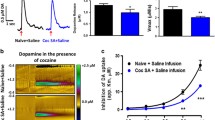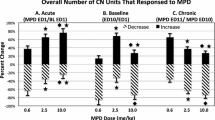Abstract
Rationale
Current medications for attention-deficit/hyperactivity disorder (ADHD) include some single isomer compounds [dextroamphetamine (d-amphetamine, dexedrine) and dexmethylphenidate (Focalin)] and some racemic compounds [methylphenidate and mixed-salts amphetamine (Adderall)]. Adderall, which contains approximately 25% l-amphetamine, has been successfully marketed as a first-line medication for ADHD. Although different clinical effects have been observed for d-amphetamine, Adderall, and benzedrine; potential psychopharmacological differences on the level of neurotransmission between d-amphetamine and l-amphetamine have not been well characterized.
Objectives
To evaluate potential differences in the isomers, we used the technique of high-speed chronoamperometry with Nafion-coated single carbon-fiber microelectrodes to measure amphetamine-induced release of dopamine (DA) in the striatum and nucleus accumbens core of anesthetized male Fischer 344 rats. Amphetamine solutions were locally applied by pressure ejection using micropipettes.
Results
The presence of l-amphetamine in the d,l-amphetamine solutions did not cause increased release of DA but did change DA release kinetics. The d,l-amphetamine-evoked signals exhibited significantly faster rise times and shorter signal decay times. This difference was also observed in the nucleus accumbens core. When l-amphetamine was locally applied, DA release was not significantly different in amplitude, and it exhibited the same rapid kinetics of d,l-amphetamine.
Conclusions
These data support the hypothesis that amphetamine isomers have different effects on release of DA from nerve endings. It is possible that l-amphetamine may have unique actions on the DA transporter, which is required for the effects of amphetamine on DA release from nerve terminals.







Similar content being viewed by others
References
Arnold LE, Heusits RD, Smelzer DJ, Scheib J, Wemmer D, Colner G (1976) Levoamphetamine vs dextroamphetamine in minimal brain dysfunction. Arch Gen Psychiatry 33:292–301
Biederman J, Faraone SV (2002) Current concepts on the neurobiology of attention-deficit/hyperactivity disorder. J Atten Disord 6(Suppl 1):S7–S16
Burmeister JJ, Moxon K, Gerhardt GA (2000) Ceramic-based multisite microelectrodes for electrochemical recordings. Anal Chem 72:187–192
Carboni E, Imperato A, Perezzani L, Di Chiara G (1989) Amphetamine, cocaine, phencyclidine and nomifensine increase extracellular dopamine concentrations preferentially in the nucleus accumbens of freely moving rats. Neuroscience 28:653–661
Cass WA, Gerhardt GA, Mayfield RD, Curella P, Zahniser NR (1992) Differences in dopamine clearance and diffusion in rat striatum and nucleus accumbens following systemic cocaine administration. J Neurochem 59:259–266
Cass WA, Gerhardt GA, Gillespie K, Curella P, Mayfield RD, Zahniser NR (1993a) Reduced clearance of exogenous dopamine in rat nucleus accumbens, but not in dorsal striatum, following cocaine challenge in rats withdrawn from repeated cocaine administration. J Neurochem 61:273–283
Cass WA, Zahniser NR, Flach KA, Gerhardt GA (1993b) Clearance of exogenous dopamine in rat dorsal striatum and nucleus accumbens: role of metabolism and effects of locally applied uptake inhibitors. J Neurochem 61:2269–2278
Fleckenstein AE, Hanson GR (2003) Impact of psychostimulants on vesicular monoamine transporter function. Eur J Pharmacol 479:283–289
Friedemann MN, Gerhardt GA (1992) Regional effects of aging on dopaminergic function in the Fischer-344 rat. Neurobiol Aging 13:325–332
Garris PA, Wightman RM (1995) Distinct pharmacological regulation of evoked dopamine efflux in the amygdala and striatum of the rat in vivo. Synapse 20:269–279
Gerasimov MR, Franceschi M, Volkow ND, Gifford A, Gatley SJ, Marsteller D, Molina PE, Dewey SL (2000) Comparison between intraperitoneal and oral methylphenidate administration: a microdialysis and locomotor activity study. J Pharmacol Exp Ther 295:51–57
Gerhardt GA, Hoffman AF (2001) Effects of recording media composition on the responses of Nafion-coated carbon fiber microelectrodes measured using high-speed chronoamperometry. J Neurosci Methods 109:13–21
Gerhardt GA, Palmer MR (1987) Characterization of the techniques of pressure ejection and microiontophoresis using in vivo electrochemistry. J Neurosci Methods 22:147–159
Gerhardt G, Rose G, Stromberg I, Conboy G, Olson L, Jonsson G, Hoffer B (1985) Dopaminergic neurotoxicity of 1-methyl-4-phenyl-1,2,3,6-tetrahydropyridine (MPTP) in the mouse: an in vivo electrochemical study. J Pharmacol Exp Ther 235:259–265
Gerhardt GA, Rose GM, Hoffer BJ (1986) Release of monoamines from striatum of rat and mouse evoked by local application of potassium: evaluation of a new in vivo electrochemical technique. J Neurochem 46:842–850
Gerhardt GA, Rose GM, Hoffer BJ (1987) In vivo electrochemical demonstration of potassium-evoked monoamine release from rat cerebellum. Brain Res 413:327–335
Goodman M, Nachman G (2000) The ADHD market: it’s time to pay attention. Morgan Stanley Dean Witter, New York
Goodman LS, Gilman A, Hardman JG, Limbird LE, Gilman AG (2001) Goodman & Gilman’s the pharmacological basis of therapeutics, 10th edn. McGraw-Hill, New York
Grady TA, Broocks A, Canter SK, Pigott TA, Dubbert B, Hill JL, Murphy DL (1996) Biological and behavioral responses to d-amphetamine, alone and in combination with the serotonin3 receptor antagonist ondansetron, in healthy volunteers. Psychiatry Res 64:1–10
Gross MD (1976) A comparison of dextro-amphetamine and racemic-amphetamine in the treatment of the hyperkinetic syndrome or minimal brain dysfunction. Dis Nerv Syst 37:14–16
Gulley JM, Zahniser NR (2003) Rapid regulation of dopamine transporter function by substrates, blockers and presynaptic receptor ligands. Eur J Pharmacol 479:139–152
Hebert MA, Gerhardt GA (1999) Age-related changes in the capacity, rate, and modulation of dopamine uptake within the striatum and nucleus accumbens of Fischer 344 rats: an in vivo electrochemical study. J Pharmacol Exp Ther 288:879–887
Hoffman AF, Gerhardt GA (1999) Differences in pharmacological properties of dopamine release between the substantia nigra and striatum: an in vivo electrochemical study. J Pharmacol Exp Ther 289:455–463
Hoffman AF, Zahniser NR, Lupica CR, Gerhardt GA (1999) Voltage-dependency of the dopamine transporter in the rat substantia nigra. Neurosci Lett 260:105–108
James RS, Sharp WS, Bastain TM, Lee PP, Walter JM, Czarnolewski M, Castellanos FX (2001) A double-blind placebo-controlled study of single-dose amphetamine formulations in ADHD. J Am Acad Child Adolesc Psychiatry 40:1268–1276
Jones CN, Hill HF, Harris RT (1974) Discriminative response control by d-amphetamine and related compounds in the rat. Psychopharmacologia 36:347–356
Kahlig KM, Galli A (2003) Regulation of dopamine transporter function and plasma membrane expression by dopamine, amphetamine, and cocaine. Eur J Pharmacol 479:153–158
Kanbayashi T, Honda K, Kodama T, Mignot E, Nishino S (2000) Implication of dopaminergic mechanisms in the wake-promoting effects of amphetamine: a study of d- and l-derivatives in canine narcolepsy. Neuroscience 99:651–659
Kuczenski R, Segal DS (2001) Locomotor effects of acute and repeated threshold doses of amphetamine and methylphenidate: relative roles of dopamine and norepinephrine. J Pharmacol Exp Ther 296:876–883
Kuczenski R, Segal DS, Cho AK, Melega W (1995) Hippocampus norepinephrine, caudate dopamine and serotonin, and behavioral responses to the stereoisomers of amphetamine and methamphetamine. J Neurosci 15:1308–1317
Luthman J, Friedemann MN, Hoffer BJ, Gerhardt GA (1993) In vivo electrochemical measurements of exogenous dopamine clearance in normal and neonatal 6-hydroxydopamine-treated rat striatum. Exp Neurol 122:273–282
Paxinos G, Watson C (1986) The rat brain in stereotaxic coordinates, 2nd edn. Academic, Sydney
Salvatore MF, Hudspeth O, Arnold LE, Wilson PE, Stanford JA, Mactutus CF, Booze RM, Gerhardt GA (2004) Prenatal cocaine exposure alters potassium-evoked dopamine release dynamics in rat striatum. Neuroscience 123:481–490
Shader RI, Harmatz JS, Oesterheld JR, Parmelee DX, Sallee FR, Greenblatt DJ (1999) Population pharmacokinetics of methylphenidate in children with attention-deficit hyperactivity disorder. J Clin Pharmacol 39:775–785
Sitte HH, Huck S, Reither H, Boehm S, Singer EA, Pifl C (1998) Carrier-mediated release, transport rates, and charge transfer induced by amphetamine, tyramine, and dopamine in mammalian cells transfected with the human dopamine transporter. J Neurochem 71:1289–1297
Smith RC, Davis JM (1977) Comparative effects of d-amphetamine, l-amphetamine, and methylphenidate on mood in man. Psychopharmacology (Berl) 53:1–12
Solanto MV, Arnsten AFT, Castellanos FX (2001) Stimulant drugs and ADHD: basic and clinical neuroscience. Oxford University Press, New York
Stromberg U, Svensson TH (1975) Differences between (+)- and (−)-amphetamine in effects on locomotor activity and l-dopa potentiating action in mice. Naunyn Schmiedebergs Arch Pharmacol 287:171–179
Yokel RA, Pickens R (1973) Self-administration of optical isomers of amphetamine and methylamphetamine by rats. J Pharmacol Exp Ther 187:27–33
Acknowledgments
These studies were supported by USPHS grants MH066393, MH01245, DA14944, and NS39787. l-Amphetamine was donated by NIH–NIDA/Division of Neuroscience & Behavioral Research. These experiments comply with all laws within the United States of America.
Author information
Authors and Affiliations
Corresponding author
Rights and permissions
About this article
Cite this article
Glaser, P.E.A., Thomas, T.C., Joyce, B.M. et al. Differential effects of amphetamine isomers on dopamine release in the rat striatum and nucleus accumbens core. Psychopharmacology 178, 250–258 (2005). https://doi.org/10.1007/s00213-004-2012-6
Received:
Accepted:
Published:
Issue Date:
DOI: https://doi.org/10.1007/s00213-004-2012-6




